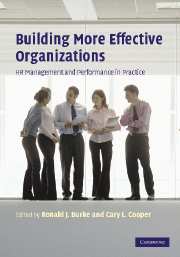Book contents
- Frontmatter
- Contents
- List of figures
- List of tables
- List of contributors
- Foreword
- Preface
- Acknowledgements
- Part I Building more effective organizations
- Part II Enhancing individual health and performance
- Part III Enhancing organizational health and performance
- Part IV Transforming organizations
- 12 Making it better – achieving outstanding performance in manufacturing organizations
- 13 Culture change in a financial services organisation
- 14 Building the sustainable organization through adaptive, creative coherence in the HR system
- 15 Be in to Win – from absence to attendance in Royal Mail Group
- 16 Transforming a company into a community
- Index
12 - Making it better – achieving outstanding performance in manufacturing organizations
Published online by Cambridge University Press: 05 June 2012
- Frontmatter
- Contents
- List of figures
- List of tables
- List of contributors
- Foreword
- Preface
- Acknowledgements
- Part I Building more effective organizations
- Part II Enhancing individual health and performance
- Part III Enhancing organizational health and performance
- Part IV Transforming organizations
- 12 Making it better – achieving outstanding performance in manufacturing organizations
- 13 Culture change in a financial services organisation
- 14 Building the sustainable organization through adaptive, creative coherence in the HR system
- 15 Be in to Win – from absence to attendance in Royal Mail Group
- 16 Transforming a company into a community
- Index
Summary
The manufacturing challenge
Say the word “manufacturing” to most people and the chances are that they will conjure up images of belching smokestacks, urban sprawl, lines of unfriendly looking machinery – all with a uniform colour scheme based on very drab grey! As for the way people fit into this puzzle that image is probably best captured by the immortal shot in “Modern Times” where Charlie Chaplin literally becomes a cog in the giant industrial machine.
The reality is, needless to say, somewhat different. Manufacturing has come a long way from the Industrial Revolution days when elements of the above picture could be seen. Visit the new BMW factory in Leipzig, for example, and you find a building designed by an award-winning architect with spacious halls, glass almost everywhere and the car assembly track weaving its aerial way in and out of the office space. Customers are invited to enjoy the experience of seeing their cars being made as well as owning and driving them. And the product itself has come a long way form Henry Ford's famous limited choice – one Model T design with two or four doors and “any colour you like – as long as it's black!” Prospective BMW owners begin by sitting with sales staff in a “design suite” in which they together configure their particular and personalised choice from the thousands of permutations of model, engine, interior trim, exterior features and add-on extras – and only when they are happy with the virtual design is it committed to physical production.
- Type
- Chapter
- Information
- Building More Effective OrganizationsHR Management and Performance in Practice, pp. 281 - 292Publisher: Cambridge University PressPrint publication year: 2007



